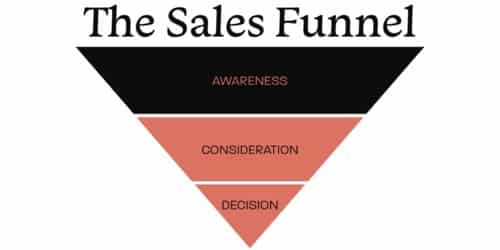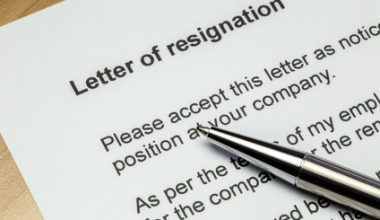A sales funnel is a diagram that shows the different steps a buyer takes before buying something. This shows a clear progression from the first contact with a customer to the customer becoming a repeat buyer. As prospects become more interested in and involved in your company’s campaigns, the marketing funnel gets smaller. This shows more serious thought and a shift toward people who might buy. This article talks about the template of b2b, Hubspot, and salesforce sales funnel stages.
Check out Buyer’s Journey: Meaning, Stages & How to Implement in Sales Process
How Does a Sales Funnel Work?
Your customers won’t know that they’re part of a sales process; they’ll just think they’re shopping. By putting ourselves in the client’s shoes, we can quickly find ways to make their experience better and more enjoyable. The easier it is for them to choose an option, the more likely they are to become a paying customer.
The top, middle, and bottom of a sales funnel are the same whether you sell houses, children’s toys, clothing, or services to other businesses. Each has different effects and nuances, and as a vendor, you have to do different things for each one.
Steps in the Sales Funnel
When you look at it step by step, a sales funnel is made up of the following:
#1. Awareness
As potential customers learn more about your business or product, they move to the top of the sales funnel. The widest part of the funnel is at the top, where the stage is. It’s possible that this is the first time they’ve heard of you, see your website, or read something about your business on social media.
The goal of this phase is to get the prospect interested enough on the first meeting that they give you their contact information (email address or phone number) in exchange for a free, valuable offer. This will also help you flesh out your client profiles and figure out who your target market is.
#2. Interest
After getting to know your brand, the next step in the sales funnel is for a possible customer to become interested in your company and what it has to offer. Online content that explains ideas related to what your business has to offer could be the first step in getting their attention. Also, the company’s brand is starting to get more respect and authority.
They become potential customers when they do things like follow you on social media, sign up for your email list, ask you questions, or send you direct messages. When they’ve found a problem or issue, the next step is to find out how your service might help them.
#3. Desire
At this point, customers are actively looking for a solution that meets their needs and fits their budget. There’s a chance that they’ll look at more than one deal. If you want your business to do well, you should give them the best solution you can.
In this step of the sales funnel, it’s important to build trust with potential customers and get to know them. Customer reviews and testimonials are a great way to show how valuable your product is and how it has helped people just like them. Don’t assume that potential customer knows everything they need to know about your offers, prices, and packaging.
#4. Action
When a customer gets to the “decision to buy” stage of the sales funnel, they are getting closer to the end goal, which is a completed transaction. Now that you have a new customer, the most important thing for your business is to meet all of their needs and go above and beyond what they expect.
You can accomplish this by providing supplementary resources for your customers, such as help articles and tutorials. Giving them tips on how to use your product well will make them feel like you value them as a customer and make it more likely that they will tell their friends about your product.
#5. Paid-for Results
Advertisements on search engine results pages are one of the best ways to get people to visit your site (SERPs).
#6. Loyalty
The goal of customer loyalty, which is also called customer re-engagement or customer retention, is to get customers to buy from a company again. To save money on the high cost of getting new customers, a good sales plan should focus on keeping customers around. Customers will keep buying from you as long as they are happy with your services and still need what you sell.
Using methods to keep customers happy can keep them satisfied and might even turn them into brand supporters. Word-of-mouth from happy customers is another important way for a business to reach more people.
Benefits of a Sales Funnel
Having a clearly defined sales funnel can help your business in many ways.
#1. Communication That Is Important and on Time
Using a sales funnel, marketers can find out more about their customers’ buying journeys and the questions and worries they might have at different points. With this information, businesses may be able to better tailor their marketing to the interests and needs of each customer.
#2. Putting Together the Functions of Sales and Marketing
If a customer is too far along in the sales funnel to talk to a rep directly, they can still get the answers they need by talking to marketing. The best sales funnels let marketers answer customer questions about their products or services before the customer even talks to a salesperson.
#3. Helps Save Time and Work
By getting rid of low-quality leads as soon as possible with a well-designed sales funnel, marketers can save their limited marketing resources for the prospects who are most likely to buy.
B2B Sales Funnel Stages
In a business-to-business transaction, a buyer usually follows a sales pipeline or funnel. Their main goal is to turn leads (potential customers) into real customers. Secondarily, it’s meant to boost the return on investment. Even though B2B pipelines are product-specific, they usually follow the buyer’s journey model of awareness, interest, desire, and action (AIDA).
Optimization of a B2B customer funnel takes a lot of time because split testing works best with a lot of traffic. If you have enough traffic and resources, start testing as soon as possible, and don’t stop until you find what works. To get more people to become paying customers, you also need the plan to influence their decisions.
The best thing to do for websites with low traffic is to find and fix any holes or splinters in the sales funnel. The majority of these issues are due to incorrect data entry fields, broken links, and missing user flow steps. Non-experimental CRO best practices can be used to supplement this. It’s also a good idea to use marketing strategies that focus on the customer.
A “typical” B2B sales funnel doesn’t exist. If you think a B2B SaaS sales funnel will be like a B2B eCommerce sales funnel or a sales funnel stages for custom solutions, you’ll be very disappointed. To properly service the various stages of the sales funnel, several specialized resources will be needed. Still, the mental and physical journeys of customers are similar enough that all B2B marketing funnels can be thought of as variations on the same theme. The following are some b2b sales funnel stages examples:
- Awareness.
- Interest.
- Evaluation.
- Engagement.
- Purchase.
- Loyalty.
Sales Funnel Stages Salesforce
The customer journey is like a sales funnel. It starts when the customer first hears about the brand and ends when they buy something. Most businesses use the sales funnel to track where their leads are in the buying process so they can change their approach for each stage.
Still, in the fast-changing digital sales world of today, the “funnel” metaphor can be misleading. In the real world, the average buyer has to deal with a lot of problems and delays. The rise of digital marketing, AI, and customer relationship management systems with lots of features has changed the way prospects are turned into customers.
When selling to other businesses, it’s important for the sales and marketing team to know how the sales funnel stages salesforce have changed and what the best ways are to move leads through the sales cycle.
How to Build a Sales Funnel Stages Salesforce Quickly and Keep It Going
Making a sales funnel doesn’t have to take a lot of time. You can set up and manage a sales funnel that helps you find and collect high-quality leads if you know what you’re doing. To build a successful sales funnel, you need to know everything you can about your leads, prospects, and customers.
#1. Look at the Customers You Already Have
The foundation of a successful sales funnel is in-depth knowledge of your current clientele. If you can get as much information as possible about your customers and analyze it, your sales process will work better. You can get information about your customers by talking back and forth with them and keeping track of what they do online and offline.
You should take into account the customer’s problems, needs, wants, goals, and aspirations, as well as how they’ve solved these problems in the past. By analyzing this information, you may target potential customers with timely and relevant communications.
#2. Captivate Your Target Audience
There are likely to be a lot of things competing for the audience’s attention. To get them to enter your sales funnel, you must first get their attention through multiple online and offline channels. Use content that does more than just inform and educate. It should hook readers and make them want to know more by showing that you understand and will meet their needs.
#3. Set up a Great Landing Page
Your writing should eventually lead people to a landing page. Your landing page should tell visitors about your company, its products and services, and the problems they can help solve. Landing pages can also be used to collect leads from interested visitors, such as their email addresses, by giving them discounts or other incentives. Last, and maybe most importantly, landing pages should have a prominent CTA that moves the prospect along the sales pipeline.
#4. Make an Email Marketing Campaign That Works
Once you have the email addresses of potential customers, you can keep in touch with them through an effective email marketing campaign. A good email marketing campaign starts with educating and informing leads about how your products and services can help them solve their problems. After that, you could offer your leads incentives to turn into paying customers. Instead of spamming potential customers with ads for your products, try to get them to buy something.
#5. Follow-Ups Should Be Done
When a customer buys something, they don’t leave the sales funnel. They stay where they should, at the bottom of the funnel. In other words, you want people who have already bought and used your goods and services to buy them again. Keeping people interested requires that you talk to them often. Send them marketing campaigns with offers and information about new products to say “thank you” for their purchase and get them to come back for more.
Hubspot Sales Funnel Stages
Using a deal pipeline can help you see how your sales process works, which can help you predict your income more accurately and spot potential roadblocks. When a deal in your pipeline moves to a higher deal stage, it means that negotiations are getting closer to a successful close. Creating a sales funnel is important for the success of any business, and HubSpot has a lot of tools to help you get started.
The HubSpot default sales funnel has seven stages: scheduled appointment (20%), qualified to buy (40%), presentation (60%), decision maker bought in (80%), contract sent (90%), closed-won (100% Won), and closed lost (0% Lost). The following is a quick rundown of the steps in the Hubspot sales funnel stages:
- Find out what your sales pipeline looks like.
- Determine the average number of prospects who go through each step.
- Find out how many tries you’ll need at each point to succeed.
- Learn the patterns that successful opportunities share at each stage.
- Use these results to build or change your sales process.
- Keep bringing in new leads on a regular basis.
- Make sure your pipeline works well.
- Keep an eye on your pipe and clean it out every so often.
- Prospecting.
- It’s important to make sure that the leads you get are good ones.
- Talk with someone or get together.
- Proposal.
- Negotiation.
- Captured the moment.
- After the fact of purchase.
Sales Funnel Stages Template
Giving your team a sales funnel that is tailored to your process will help everyone see what they need to do in the big picture to close more deals. The following are some sample steps from a sales funnel stages template:
#1. Sales Channel for a Financial Brokerage
One way to describe a brokerage is as a company that acts as a go-between for customers and different vendors. Like any other sales funnel, a brokerage starts with marketing to raise brand awareness. Next, education and nurturing are used to test the waters with potential clients.
For brokers, the third stage of the sales funnel is especially important because it’s a little different from how the funnel is usually set up. When clients ask for prices, brokers can give them a sales quote that includes a list of the options. The customer wants to buy something.
#2. Product Launch Sales Funnel Template
A product launch funnel is used to market and sell a new product when it comes out on the market. It’s a type of marketing funnel made to get people interested in and buying a brand-new product or service.
#3. The Model of the Tripwire Sales Funnel
A tripwire sales strategy is one that uses a low-cost, high-value add-on to make it more likely that a customer will buy the main product later on.
#4. Cancellation Sales Funnel Template
Any business would be upset that the customer chose to cancel. Still, that’s not the end of the world or the relationship with the customer. With the right cancellation sales stages funnel template, you may be able to bring back customers who have already stopped using your product or service.
Any online business can use a sales funnel, even if the products or services they sell are easier to explain on social media or through email than in the brokerage, B2B, SaaS, or enterprise markets.
This social media sales funnel plans to bring in customers for a product by using the tried-and-true AIDA method. Targeted social media posts can help spread the word, emails sent to prospects who have signed up can pique their interest, an online event can help people make decisions, and a presentation of your product can get people to take action.
What Are the 4 Stages of the Sales Funnel?
The sales process has four steps: thinking about it, researching it, thinking about it again, and buying it. These steps can help you improve your sales process and get potential customers to buy from you.
What Are the 7 Layers of the Sales Funnel?
The following are;
- Awareness.
- Interest.
- Evaluation.
- Choice and Dealing.
- Sale.
- Renewal.
- Repurchase.
- Revive dormant leads.
What Are the 3 Stages of the Sales Funnel?
But the funnel can be made easier to understand with a three-step model: “Awareness” is at the “top of the funnel” (TOFU). Consideration, which is right in the middle of the MOFU. BOFU is the last step before becoming a Christian.
What Are the Levels of the Sales Funnel?
The three levels of a sales funnel are the same as the three steps a customer goes through. Prospects go through the following stages, as the sales funnel’s structure demonstrates: The process goes from not having any contacts (leads) to qualifying, making a proposal, negotiating, and finally winning.
What Are the 5 Stages of Sales Funnels?
There are five of them: awareness, curiosity, eagerness, willingness, and the ability to act, which leads to loyalty.
What Are the 5 Sales Stages?
The following are;
- Tell the customer what you’re doing.
- Find out what the customers want.
- Find a way to fix it.
- Get the deal done.
- Follow-up is important if you want to close the deal.
Conclusion
The sales funnel is a way for buyers and sellers to plan out the steps they need to take to close a deal. The number of prospects at each stage of the sales cycle at any given time is shown as an inverted pyramid, or funnel, which is where the term comes from. Creating a sales funnel for your company is best done by dividing the process into distinct steps.
Related Articles
- SALES FUNNEL: Meaning, Stages, Template & All You Need
- MARKETING VS SALES: What Are the Major Differences?
- SALES FUNNEL: Definition, Types, and What You Must Know
- CONVERSION FUNNEL: Strategies For Optimization Of The Sales Funnels
- SALES REPORT: SALES REPORT: What It Is, Objectives, and How to Write It






